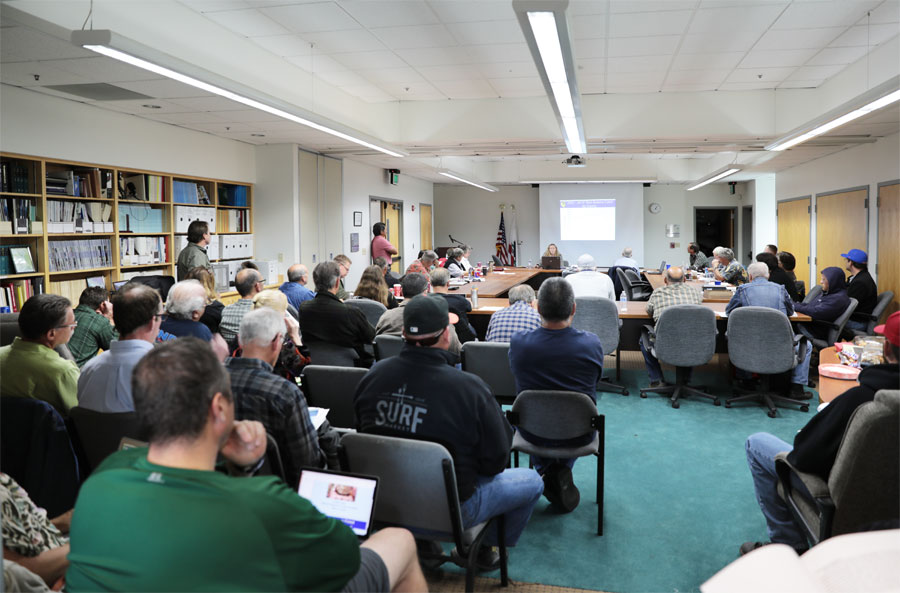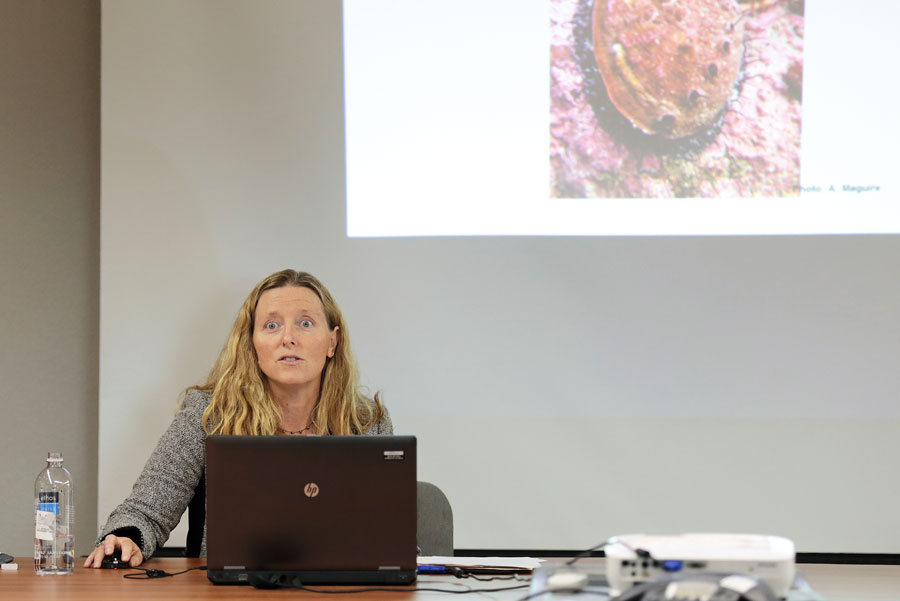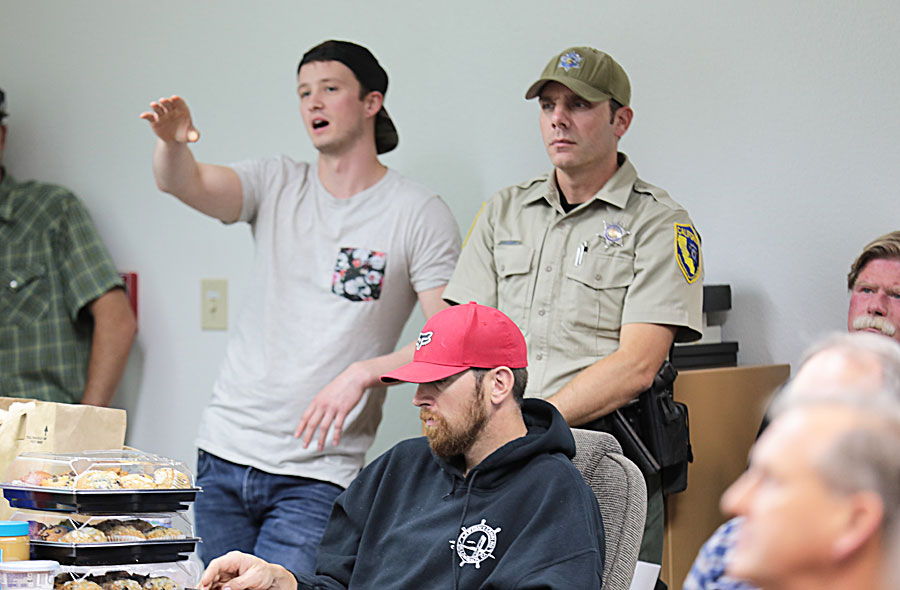Last Saturday, November 5, 2016, the California Department of Fish and Wildlife (CDFW) Director’s Recreational Abalone Advisory Committee (RAAC) held a public meeting to discuss proposed regulation changes to the recreational red abalone fishery for 2017. The meeting was held in Cotati (near Santa Rosa), and included presentations on law enforcement efforts, environmental factors affecting the abalone population, information from regional surveys of abalone populations, the expenditure report for funds generated through the sale of abalone report cards, and proposed emergency regulations to further restrict the taking of abalone on California’s northern coast in 2017. (The full meeting agenda can be viewed here). The meeting was also open to public questions and comments and the audience of 40+ avid divers weren’t shy to share their thoughts on the research and potential new regulations.
Based on prior feedback, the meeting was held at a location and time that could accommodate as many north coast divers as possible. Cotati, just south of Santa Rosa, was the location selected and made it possible for a sizeable crowd of concerned divers to attend. NorCal underwater hunters and Northern California Skin Divers provided $200 worth of pizza and sodas for lunch for the public that attended.
The proposed emergency rules being drafted by CDFW is in response to adverse environmental conditions, with more specific concern over warm ocean waters, a recent large die-off of bull kelp, and a dramatic population increase of sea urchins, which compete with abalone for food. The changes outlined in the proposal are intended to reduce pressure on the abalone fishery under the guidance of the Abalone Recovery and Management Plan.
The recreational abalone fishery was recently assessed at a value of $44 million to the fishermen.
The Saturday meeting was attended by both fishery constituents and interested members of the public, and more than 40 recreational abalone divers and committee members attended to discuss, and at times argue, the conclusions made and the new proposed rules that could both reduce season limits and shorten future abalone diving seasons. It offered an opportunity for north coast divers to provide input and make an impression on the commissioners about what action they want based on the latest data.
The nine-member RAAC committee includes Chris Voss of Santa Barbara, a former commercial abalone diver and President of the California Abalone Association; Steve Benavides of Newport Beach, member of the Greater Los Angeles Council of Divers; Dennis Haussler of Redwood City, member of Central California Council of Diving Clubs, Inc. – CenCal; Doug Laughlin of San Mateo, member of Coastside Fishing Club; Rocky Daniels of Cotati, member of the Sonoma County Abalone Network (SCAN); Peter Haaker of Westminster, retired CDFW Senior Biologist Specialist on abalone; Steve Riske of Bodega Bay, CDFW Warden Captain; Brooke Halsey of Marin County, Attorney at Law; and Ian Taniguchi of Long Beach, Senior Marine Biologist, CDFW, and the RAAC Chairperson.
“The Recreational Abalone Advisory Committee (or the RAAC) was formed to give advice to the DFW commissioners before they make a vote on abalone rules and regulations”, attendee Steve Watson shared. “The DFW Commission is a 5 man panel who oversees all regulations and their changes and modifications.”
Warm Water, A Loss of Kelp Causes Concern for Biologists
Laura Rogers-Bennett from the California Department of Fish and Wildlife and the UC Davis Wildlife Health Center presented findings from research showing a reduction of kelp along the north coast. Her findings indicate that Northern California kelp forests have been reduced to an all-time low and abalone populations have suffered due to a “perfect storm” of large-scale ecological impacts. Environmental stressors include a toxic algae bloom off the Sonoma coast in 2011, a widespread sea star disease in 2013 that was followed by an explosion in the sea urchin population, and unusually warm water conditions that have persisted offshore since 2014.
Taken from both local site surveys and “fly over” surveys done by airplane, she noted that there has been a 93% loss of kelp between 2008 and 2014 in the Van Damme, Point Arena Cove, Timber Cove, and Fort Ross. Underwater, the population of purple sea urchins has also exploded to as much as 60 times the historic densities in northern California. Combined with persistent warm water conditions, as much as 25% of abalone tested at key sites have shrunken in size, and their reproductive abilities have been substantially reduced as well due to a lack of adequate food sources.
“Bull kelp is an annual species that lives for only one year, successful re-establishment of new kelp every year is critical”, Laura Rogers-Bennett explained. “Without successful reproduction every year, the kelp forest may be unable to grow back to its full potential.”
The dramatic rise in urchin populations is also problematic – purple sea urchins are voracious consumers of kelp and in large numbers, they can easily wipe out vast expanses of kelp and other algae, changing the landscape from a lush and diverse kelp forest ecosystem to what is known as an “urchin barren”.
Information Disputed
After presenting her facts and findings, both the data and conclusions weren’t accepted by many divers in attendance and they weren’t afraid of sharing their thoughts. Based on their first-hand experience diving along the Sonoma and Mendocino areas, some of the information didn’t ring true to those who dive the same areas regularly, and other information was claimed to be outdated, improperly interpreted, and with some points, completely false.
“Lies, lies, and more lies” attendee Mark Wells told us. “They are giving us information that is completely false and hoping we’ll all just go away. I’ve been diving this coast for 20 years and it’s easy to see that they’re wrong.”
Several divers, including Joshua Russo of the RAAC, noted that while the kelp cover has declined in recent years, it is clearly on its way back to recovery, and areas that were barren last year have kelp growing there now. It was also noted, and acknowledged by the CDFW, that the kelp growth and die-off cycles have only been studied for a very short period of time. Many divers attending the meetings felt that drawing conclusions based on the limited data available is not the proper way to manage the fishery.
Sonke Mastrup from the California Department of Fish and Wildlife acknowledged that much of the data is incomplete, and long-term cycles aren’t completely understood. He also shared, “We don’t have all of the information, but we have to operate on the information we do have, and we can’t afford to be wrong on this one. If we are (wrong), it could take a full human generation for the abalone to recover, if they are able to recover at all.” He also restated several times that there are too many uncertain ongoing environmental conditions taking place that may or may not continue in the future and that it was prudent to take action now to protect the abalone populations.

Joshua Russo of the Sonoma County Abalone Network (SCAN) and Recreational Abalone Advisory Committee (RAAC) emphasizes that kelp is recovering, contrary to the findings of the CDFW.
Diver Steve Watson share with us his concern about not only the abalone, but the impact on the local economy as well. “To limit fallout and outrage they are hitting the easy targets like the law abiding abalone divers. This will only create financial disaster for north coast businesses which rely heavily on the divers who come from near and far to dive, visit and buy from the local merchants. This picture is much bigger than it seems on the surface. From what I could see and hear the DFW does not seem to concerned with north coast business and the impact their decisions have on those businesses. This is going to affect more than just abalone fishermen.”
Emergency Regulations Proposed
Ultimately, the CDFW is proposing two possible solutions to reduce the take of abalone and reduce what they believe is essential to save the fishery. Neither one was a good option for many attendees.
The changes are being recommended based on six different factors: All indicators (to the health of the abalone population) are negative, previous reductions appear ineffectual, precautions are warranted, the consequence of failure could be generational, the changes will only affect 1/3 of fishers, and that fishing is not the cause of the problem, but too much fishing could make the problem much worse.
The first option presented (titled “Balancing uncertainty and risk with impacts”) is to reduce the annual limit of abalone to 9 per diver, and closing the month of November to abalone diving (the season currently runs from April 1 through Nov. 30, 2016, with a one-month closure in July). The current annual limit is 18, so the limit would be reduced by 50%.
The second option (titled “Full ARMP Solution”) would be to reduce the annual limit of abalone to 9 per diver, and closing the months of November and April to abalone diving.
Next Steps
The final decision hasn’t been made regarding new regulations, and there are a number of upcoming discussions still to take place to address the potential emergency action. Final action could take place as early as December 7 for changes to the 2017 season.
Those who wish to provide input into the decision are being encouraged to do so by emailing fgc@fgc.ca.gov.
. . .
Please share your comments below!
. . .
Related Links & Resources:
California Department of Fish and Wildlife
NorCal underwater hunters
Northern California Skin Divers
Abalone Recovery and Management Plan
UC Davis Wildlife Health Center
CDFW: “Perfect Storm Decimates Kelp”
Watch the meeting on YouTube:




